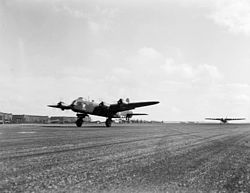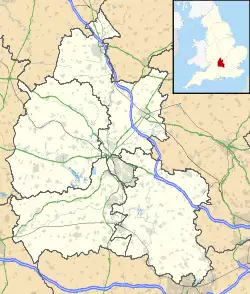| RAF Harwell | |
|---|---|
| Harwell, Oxfordshire | |
 A Short Stirling of No. 295 Squadron RAF, taking off from RAF Harwell towing an Airspeed Horsa glider, 17 September 1944. This was one of 25 Stirling/Horsa combinations which carried the Headquarters of I Airborne Corps to landing zones near Groesbeek, Nijmegen as part of Operation Market Garden | |
| Coordinates | 51°34′30″N 1°18′43″W / 51.575°N 1.312°W |
| Type | Royal Air Force station |
| Site information | |
| Owner | Air Ministry |
| Controlled by | |
| Site history | |
| Built | 1914 |
| In use | 1914-1945 |
| Battles/wars | Second World War |
Royal Air Force station Harwell or more simply RAF Harwell is a former Royal Air Force station, near the village of Harwell, located 4.8 miles (7.7 km) south east of Wantage, Oxfordshire and 17 miles (27 km) north west of Reading, Berkshire, England.
The site is now the Harwell Science and Innovation Campus which includes the Rutherford Appleton Laboratory.
History
The airfield was built by John Laing & Son at the junction of three parishes in 1935.[1] The bulk lay within Chilton parish; about a third was in East Hendred; and the smallest portion was in Harwell. The first Commanding Officer, upon being asked what the name of the new airfield should be, responded that it should be named after the parish in which his house lay – and this happened to be Harwell.[2]
From its opening in February 1937 until March 1944, various bomber squadrons were stationed at the airfield. On the outbreak of the Second World War, it became part of No. 38 Group RAF, initially used for leaflet missions over France using Vickers Wellington bombers, later bombing raids on Bremen, Cologne and Essen. There were numerous Luftwaffe raids on the airfield from August 1940 until September 1941. The original grass field was replaced with concrete runways between July and November 1941.[3]
The following squadrons were posted to Harwell:
- No. 75 Squadron RAF.[4]
- No. 105 Squadron RAF.[5]
- No. 107 Squadron RAF.[6]
- No. 148 Squadron RAF.[7]
- No. 215 Squadron RAF.[8]
- No. 226 Squadron RAF.[9]
- No. 295 Squadron RAF.[10]
- No. 570 Squadron RAF.[11]
In March 1944, it was reallocated to 30 Group Airborne Forces, where it mainly operated tug aircraft towing Airspeed Horsa gliders. These gliders were used in a number of operations including carrying troops into Normandy to secure vital strategic positions in advance of the main landings on D-Day. In fact the first glider-borne troops to arrive in Normandy on D-Day came from RAF Harwell. A memorial to the men who flew from RAF Harwell who were killed on this operation now exists at one edge of the old airfield site, and a memorial service is held there annually. The airfield was also used briefly for Special Operations Executive (SOE) operations between July and September 1944.
Closure and subsequent use
The RAF station was closed at the end of 1945 and the site transferred to the Ministry of Supply on 1 January 1946, where it became the Atomic Energy Research Establishment. Over the years that reduced in scale and other science-based research moved in, such as the Rutherford Appleton Laboratory in 1957. The site is now home to the Harwell Science and Innovation Campus.
References
Citations
- ^ Ritchie, p. 91
- ^ Hance, Nick (November 2006). Harwell: The Enigma Revealed (1st ed.). Buckland, Oxfordshire: Enhance Publishing. pp. 13–14. ISBN 0-9553055-0-0.
- ^ "RAF Harwell airfield". Control Towers. Retrieved 7 June 2013.
- ^ Jefford 2001, p. 48.
- ^ Jefford 2001, p. 54.
- ^ Jefford 2001, p. 55.
- ^ Jefford 2001, p. 62.
- ^ Jefford 2001, p. 71.
- ^ Jefford 2001, p. 73.
- ^ Jefford 2001, p. 84.
- ^ Jefford 2001, p. 97.
Bibliography
- Jefford, C.G. RAF Squadrons, a Comprehensive Record of the Movement and Equipment of all RAF Squadrons and their Antecedents since 1912. Shrewsbury, Shropshire, UK: Airlife Publishing, 2001. ISBN 1-84037-141-2.
- Ritchie, Berry (1997). The Good Builder: The John Laing Story. James & James.

